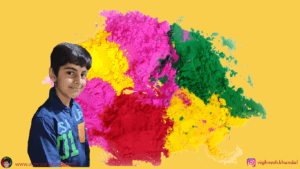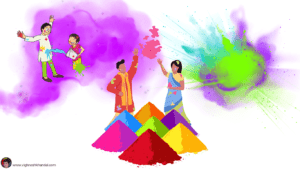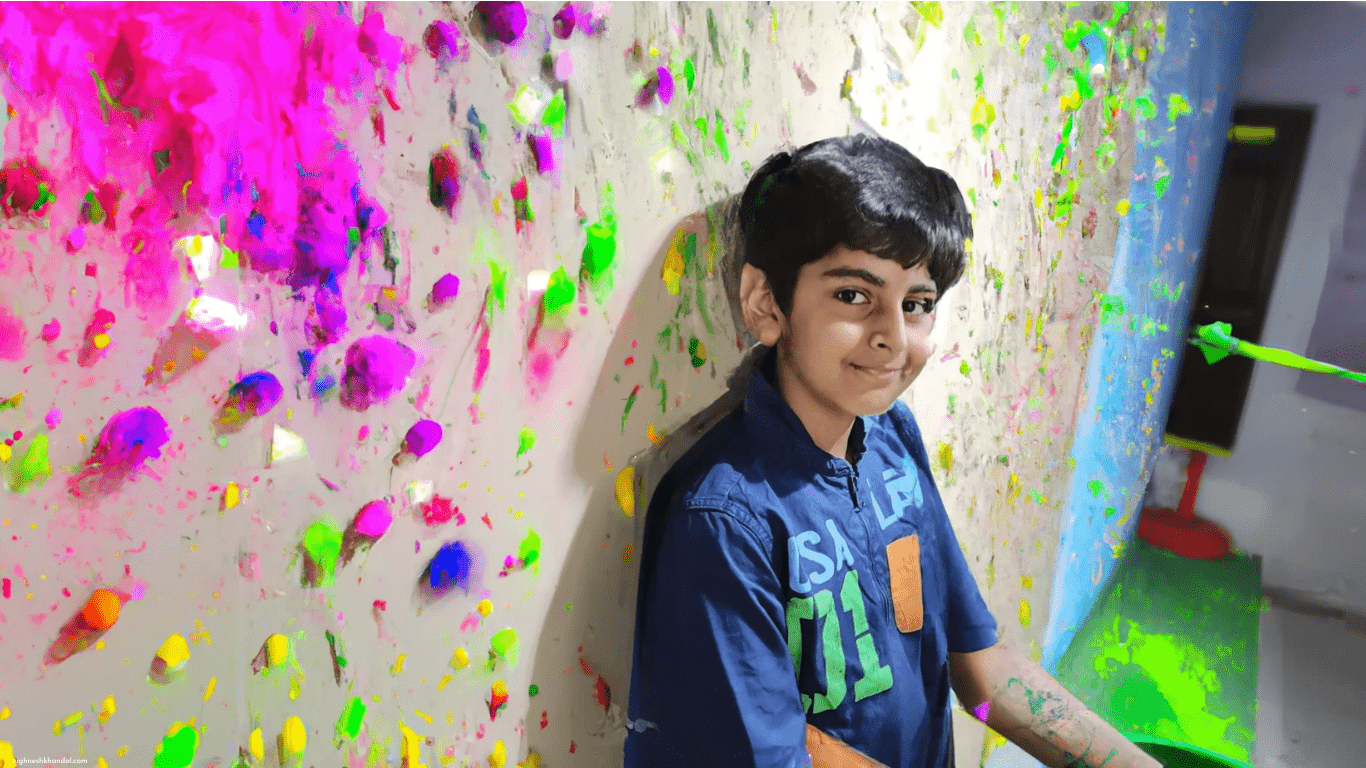My Favourite Festival
Holi is one of the most vibrant and exciting festivals in India. It is also a great celebration of unity and brings people from all walks of life together to celebrate it.
It is a two-day festival that takes place in March. The first day is called Holika Dahan, marking the defeat of evil powers.
Holi and Vishnu
Holi is a Hindu festival that marks the end of winter and the beginning of spring. It is celebrated as a celebration of love, joy and friendship.
It is a celebration of the victory of good over evil. The festival is based on the story of Hiranyakashipu and his son Prahlad.
Hiranyakashipu
In ancient India, a demon king named Hiranyakashipu wanted to take on Lord Vishnu. He did extensive penance and prayer for years to gain boons from the gods that included invulnerability.
He also gained sole lordship over all the living beings and presiding deities (according to Hindu belief), but he was very arrogant. He commanded everyone to worship him and killed any who refused to do so.
However, Hiranyakashipu’s son Prahlad was a devoted devotee of Lord Vishnu, and he kept on praying to him. When Hiranyakashipu tried to kill him, he was poisoned, but the poison turned into nectar in his mouth.
The holi festival story is very important as it teaches us that no matter how evil someone may be, if you have faith in God, you can overcome even the most powerful forces. Therefore, the holi festival celebrates the victory of good over evil, and people express their love and devotion towards God.
Prahlad
Holi is the second most celebrated festival in India. It is based on various legends and celebrates the victory of good over evil.
The story behind the holi festival is related to the demon king Hiranyakashyap and his son Prahlad. Hiranyakashyap wanted everyone in his kingdom to worship him as the supreme God, but Prahlad, a Vaishnava, refused to do so.
He remained loyal to Lord Vishnu, and the demon king tried everything he could to kill him. But each time, he was defeated by Vishnu.
The most famous story associated with the holi festival is the one of Prahlad and Holika. As the story goes, Hiranyakashyap was upset when he discovered that his son Prahlad had become a devotee of Lord Vishnu. He then enlisted the help of his sister Holika to kill him.
Holika
Holi is a popular festival celebrated in India for two days. It is a Hindu festival that celebrates good over evil. It originated from a story about the demoness’s sister Holika and Prince Prahlad.
The legend goes that a tyrant king named Hiranyakashyap wanted to kill his son Prahlad. Prahlad refused to worship him and worshipped Vishnu.
Angered by his defiance, the king and his sister Holika tried various methods to kill him. But every time, Prahlad escaped unscathed.
Eventually, the tyrant king and his sister Holika plotted to kill him by tricking him into sitting on a pyre with her. But Prahlad escaped the fire as his magic powers saved him.
Vishnu
Vishnu is one of Hinduism’s main deities and was the world’s creator. He is also the preserver and protector of the earth and has been incarnated multiple times.
In the holi festival, devotees celebrate the victory of good over evil. The story behind this festival is the defeat of Hiranyakashipu and his sister Holika by Lord Vishnu.
According to the story, Hiranyakashipu was a demon king who received a boon from Brahma that made him immortal. He began to oppress all but one in his kingdom – Prahlad, a devotee of Vishnu.
The demon king tried to kill Prahlad many times, but the God Vishnu saved him from death each time. This is why on the day of Holi, people celebrate the victory of good over evil by applying colour to their skin.
There are many festivals that India has to offer, each with its unique traditions and culture. Holi is one such festival.
It celebrates the victory of good over evil. It’s also a celebration of love and friendship.
It’s a festival of colours.
In India, colour is a central part of life. The country’s vibrant culture and tradition celebrate life’s moments in bright hues.
Holi is one of the country’s most beloved festivals, honoring spring and celebrating the victory of good over evil. It also marks the end of winter and the arrival of spring harvests.
The day of Holi is a time for families and friends to play with colours. Men and women carry powders called gulal, smearing colours on each other’s faces and clothes.

They also play water games, sprinkling coloured liquids on each other and splashing them in the air. They sometimes use water guns or balloons.
The colours of Holi represent different themes, including new beginnings and rebirth. Red symbolizes love and fertility; yellow is a sign of turmeric, a spice native to India known for its healing properties; blue represents the Hindu god Krishna; and green is for new growth.
Why My Favourite Festival is Holi – It’s a festival of love
Holi is a celebration of love and friendship, a day when people forget their enmity and become friends to start a new chapter in life. It’s also a day when people tuck into delicious Indian street food, drinks party drinks and play with colours (cornstarch-based powder of different hues) to bring out the best in themselves and others.
In Hindu tradition, the festival celebrates the arrival of spring and the triumph of good over evil. It draws its roots from a story of a demon queen named Holika and her brother Hiranyakashipu who tried to kill Prahlad, their son who worshipped Lord Vishnu instead of them.
A fire called Holika Dahan is lit the night before the festival, symbolizing the triumph of good over evil in this story. The next day, kids gather around bonfires to throw natural coloured powders (gulal) made of medicinal herbs like neem, kumkum, haldi and bilva.
Holi is a festival of friendship
Holi is a Hindu festival of colours celebrating good’s victory over evil. It’s rooted in several Hindu legends, but the prime theme is the triumph of love over anger, greed and envy.
People throw coloured powder, or gulaal, at each other. It’s a fun way to celebrate the arrival of spring and new life.
Aside from being a religious holiday, Holi is also an opportunity to celebrate friendship with those around you. In India, a large number of people participate in the festival.
In a city like Redmond, where I live in Washington State, people gather to celebrate Holi at the Lotus Temple. The day’s festivities include music, food, and colourful powder. A multicultural group is attending the celebration, and they’re all welcome to join in on the fun regardless of their religion or affiliation.
It’s a festival of fun.
Holi is a festival of colours that celebrates the arrival of spring. It also marks a time for building relationships through play and laughter.
The festival is celebrated with much excitement and enthusiasm. It lasts for a day and a night and is known by many names in different regions of India.
It is a day when people come together, forgetting all their resentments and past conflicts. They enjoy the fun of playing with colours and rejoicing in the triumph of good over evil.
Ahead of Holi, Hindus prepare for the festivities by preparing food and stoking bonfires in parks and community centres. The pyres are lit to represent Holika Dahan, the first evening of the festival.
The next day, everyone heads to the streets for a colour fight. The colour-throwing tradition is said to have roots in the story of Hiranyakashayap and his sister Holika who tried to kill their son Prahlad, a devotee of Vishnu.
Colours are a big part of Indian culture and celebrations. And holi is no exception to this rule.
It’s a festival that celebrates happiness and love and brings people together from all over the world. It’s a time to play and have fun but also to let go of all the negative emotions that might be holding you back from enjoying your life to the fullest.
The festival’s roots lie in the story of Krishna and Radha. As a baby, Krishna’s skin turned blue because he had drunk poisonous milk from a demon. It’s said that after he fell in love with Radha, he began to smear her with brightly coloured powders.
Holi is celebrated across India and has become a popular event in many parts of the world. However, it’s particularly popular in northern India and Nepal. In those regions, it’s mainly a song and dance-based event.
It is a festival of love.
Holi is a colourful festival that celebrates spring, love and new life. It’s fun for everyone to play with powder paint and coloured water.
Hindus in India and Nepal celebrate it, but it’s also a popular holiday outside the region. People in countries like Bangladesh, Pakistan, and Trinidad and Tobago also celebrate Holi.
The festival is based on stories in Indian mythology. One story concerns the demon king Hiranyakashipu and his sister Holika.
According to Sushma Jansari, curator of South Asia at the British Museum, “Holika was so egoistic that she tried to kill her devotee Prahlad.” After she was incapacitated in holy fire, Holika was forced to submit to Lord Vishnu.
During the celebrations, people smear each other with a mixture of coloured powder, known as gulal, and water called pani. These colours symbolize different things, and each one holds a special meaning.

It is a festival of friendship.
The holi festival is a great opportunity for people to bond and strengthen friendships. Whether it’s through throwing wet or dry colours or sharing food or water guns, this celebration is a fun way to celebrate the start of spring and bring friends together!
It also allows us to show off our skills and try new things. It’s a perfect chance to experiment with food and drink and get creative!
On the first day of the festival, called Chhoti Holi, people gather and throw wheat sheaves, coconuts and green chickpeas into bonfires. It’s a nod to the folk story about Hiranyakashayap and his sister Holika who conspired to kill their son Prahlad, a devotee of Lord Vishnu.
On the second day, dubbed Rangwali Holi, people gather in parks and other public places to play with colours. The colours are typically made from gulal, a mixture of dried flowers and other herbs. The colour throwing and smearing are meant to symbolize the fight against negativity.
It is a festival of unity.
A festival of new beginnings, holi celebrates the end of winter and the start of spring. It also marks the victory of good over evil and is rooted in Hindu mythology.
A two-day celebration, holi takes place on Purnima (the day of the full moon) and is a mix of religious and social rituals. On the night before, community bonfires are lit to commemorate a folk story about the burning of Holika, the sister of King Hiranyakashyap, who tried to kill his son Prahlad for worshipping the Hindu god Vishnu.
The next day, people gather in the streets and celebrate in a fun way. Children and adults fill water balloons, play with water guns and throw powdered colours at each other — everyone is welcome!


